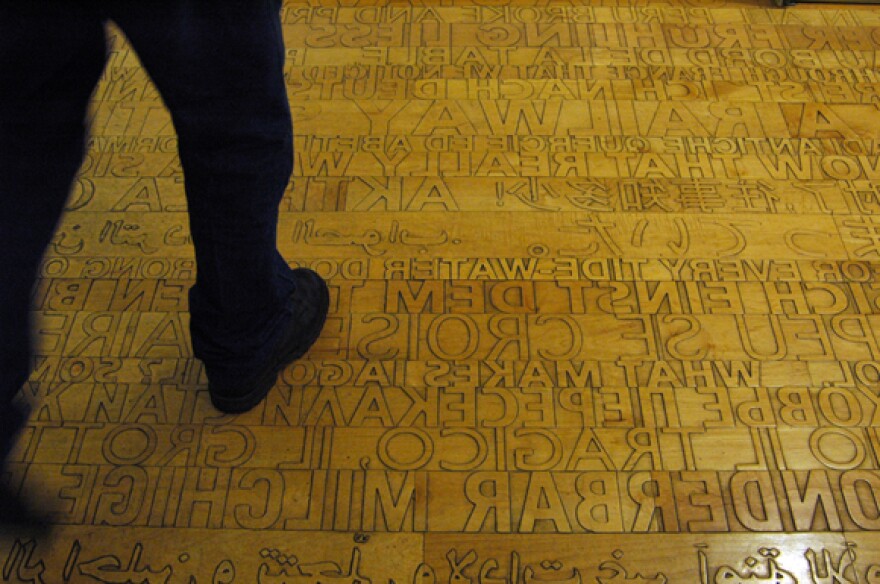A new show at Seattle's Henry Art Gallery invites you to do something museums usually forbid: Touch the art and take it home.
Four galleries are filled with photographic images printed on tablets of newsprint. Visitors are invited to tear off the images. That means the galleries are in constant flux, and, at some point, they could be entirely left void.
It’s all part of the museum-wide “Ann Hamilton: the common S E N S E” exhibit. Hamilton is one of the country’s most distinguished artists and a MacArthur genius known for creating large-scale immersive works.
Arguably one of her most popular works was her 2012 installation in New York’s Park Avenue Armory that featured a larger-than-life white curtain that ebbed and flowed whenever anyone swung on one of 42 swings.

The Ohio artist is also no stranger to Seattle audiences. She’s the creator of a large swath of maple floorboard rooted inside the downtown public library’s LEW collection, which stands for literacy, ESL (English as a Second Language) and world languages. The floorboard is covered with sentences in the 11 languages most commonly found in the collection's books.
Her work also occupied the Henry in 1992. An installation called “Accountings” featured candle-sooted walls, votive candles and 200 free-flying canaries.
This time, the Henry invited Hamilton to inhabit a much larger and newly-transformed building. Skylights have been uncovered and walls have been temporarily taken down. Visitors encounter a different and more open space while engaging with Hamilton’s installation that focuses on touch.
'Touch Has A Consequence'

The show draws on something Aristotle wrote: that touch is the sense that’s common to all animal species. Hamilton pulled from all corners of the University of Washington for her installation, including the special collections of the libraries, the Henry’s costumes and photographs, and the animal specimens of the Burke Museum of Natural History and Culture.
While researching at the Burke, Hamilton had a singular moment when she came across an Olympic marmot.
“Its hands were upturned, and there was a real sense of emotional connection for me," she said.
She saw its hands and recognized her own. She contemplated how its hands touched the ground.
“And it’s really from that kind of emotion that this whole project grew," she said.
Hamilton used a low-resolution scanner to print images of dozens of mammals, birds and amphibians. The results are blurry images with only what was pressed against the glass coming into focus — an underbelly, a chin, a pair of claws. All of the images were then published on large-format tablets that wallpaper the interior of the galleries.
There are stools available in case you want to climb up and tear off one of the images hung up high. And what if you tore off a whole bunch? That’s also what Hamilton is getting at. There’s a shared responsibility here — a give and take, a common experience and, of course, the act of making something extinct.
“When we touch, we’re always touched in return,” she said. “And touch has a consequence.”
Exploring Other Forms Of 'Touch'
The second part of the exhibit features animal skin costumes and garments — fox fur, gut, buckskin — laid atop carts. The carts are wrapped like hospital beds and dressed with tall curtains. You’re invited to pull back the curtains and “touch” with your eyes. The garments are under display glass.
The third part of the exhibit features modernized bullroarers, which are ancient musical instruments that were used to call someone across a long distance. A whirring sound is made by spinning a roarer. Hamilton’s version is mechanized spinning instruments on poles that occupy an entire first-floor gallery.
“Hearing is how we touch at a distance,” Hamilton said. “When several of them go off you really feel the air. You feel the pressure.”
You’re touching with your ear.
An Evolving Experience
“It’s not like a quick read,” Hamilton said about the exhibition. “It’s an experience.”
And it’s an experience that’s changing all the time, what with the depleting photographic images and the occasional presence of University of Washington choral singers singing aloud and reader-scribes reading aloud to the photographic images.
“The Common S E N S E” is also collecting submissions of text that’s about an exchange or a register of touch. You can upload a submission to aTumblr site. You can also volunteer to be a reader-scribe. And at the museum’s entrance, you can choose to leave behind your own photographic image. Hamilton hopes those images will accrue and eventually be displayed in the galleries.







